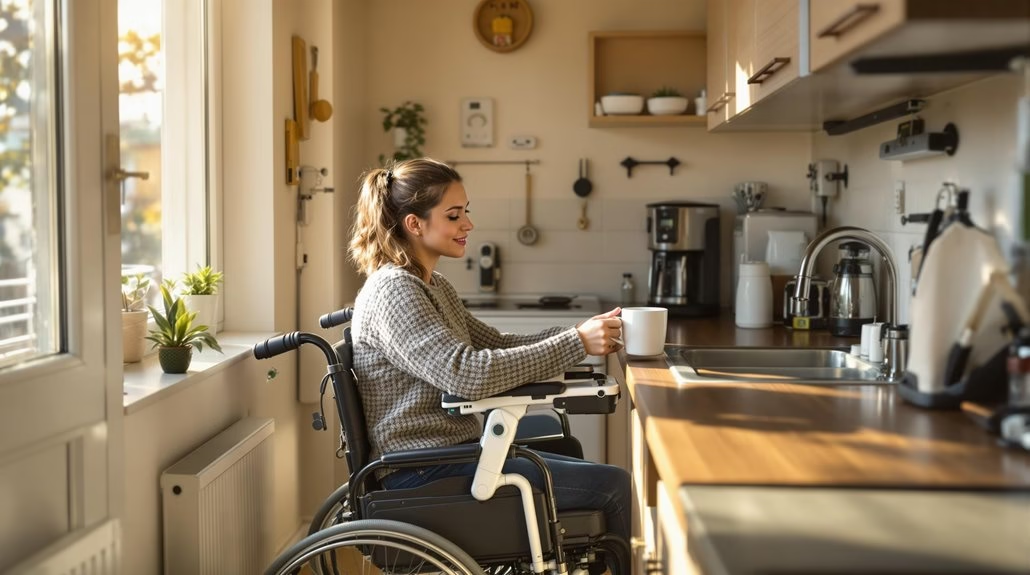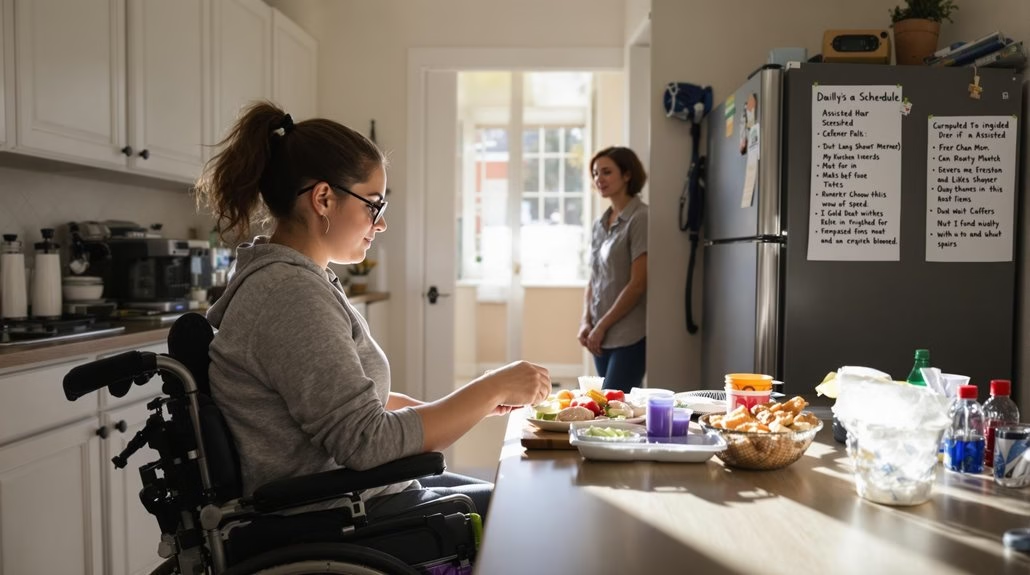Support someone with cerebral palsy by practicing active listening and allowing them time to communicate without interruption. Create an accessible environment by removing obstacles and installing safety features like non-slip flooring and ramps. Always ask before helping, and respect their independence by letting them set the pace for activities. Focus on clear communication while maintaining eye contact at their level. Understanding these fundamentals will open the door to providing even more meaningful support.
Understanding Cerebral Palsy and Its Impact on Daily Life
While cerebral palsy affects each person differently, it’s a neurological condition that impacts movement, balance, and posture.
You’ll find that individuals with cerebral palsy may experience varying levels of muscle coordination, speech difficulties, and sensory challenges that influence their daily activities.
Understanding these daily challenges is essential when supporting someone with cerebral palsy. They might need assistance with tasks like eating, dressing, or mobility, depending on the condition’s severity.
Supporting individuals with cerebral palsy requires understanding their unique needs and providing appropriate assistance with everyday tasks.
Many individuals benefit from therapeutic interventions, including physical therapy, occupational therapy, and speech therapy to enhance their independence and quality of life.
Skilled nursing staff can provide specialized care management for those with cerebral palsy, focusing on creating nurturing environments that promote overall well-being.
Effective Communication Strategies and Active Listening
Communication forms the foundation of meaningful support for individuals with cerebral palsy. When you’re engaging with someone who’s CP, it’s crucial to focus on both verbal and nonverbal cues while maintaining a patient, respectful approach.
- Pay attention to facial expressions, gestures, and body language, as these nonverbal cues often convey important messages.
- Give the person enough time to express themselves without interrupting or finishing their sentences.
- Practice empathetic responses by acknowledging their feelings and validating their experiences.
- Maintain eye contact and position yourself at their eye level when possible to create a more comfortable interaction.
Remember that everyone communicates differently, so stay flexible and willing to adapt your communication style. Ask directly about their preferred method of communication and respect their choices. Consider scheduling a personalized phone consultation to better understand their specific communication needs and preferences.
Creating an Accessible and Safe Environment
Creating a safe and accessible environment helps individuals with cerebral palsy maintain their independence and dignity. Focus on implementing accessible design features like wider doorways, non-slip flooring, and grab bars in bathrooms.
Thoughtful accessibility modifications empower those with cerebral palsy to live independently while preserving their sense of dignity and self-reliance.
Install ramps where needed and guarantee clear pathways throughout living spaces.
Consider essential safety measures such as removing trip hazards, securing loose rugs, and maintaining proper lighting in all areas.
You’ll want to organize furniture to allow easy navigation with mobility aids and adjust counter heights for comfortable reach.
Make frequently used items easily accessible by storing them at appropriate heights and using pull-out shelves or lazy Susans.
Remember that each person’s needs differ, so consult with the individual about specific modifications that would best support their daily activities and promote their autonomy.
Skilled nursing care professionals can provide expert guidance on proper home modifications and safety measures while delivering 24/7 medical monitoring.
Promoting Independence While Offering Assistance
Providing the right balance of support for someone with cerebral palsy means knowing when to help and when to step back. By encouraging self-sufficiency and fostering decision-making, you’ll empower them to maintain their independence while ensuring they’ve the assistance they need.
- Ask before helping – don’t assume they need assistance with every task
- Let them set the pace and communicate their preferences for support
- Offer choices and respect their decisions about daily activities
- Support their efforts to try new things, even if it takes longer
Remember that your role is to be present and supportive while allowing them to develop their capabilities.
When you notice them struggling, wait for them to request help rather than jumping in immediately. This approach builds confidence and preserves their sense of autonomy.
Consider working with skilled home care professionals who can provide specialized therapy services to help improve mobility and daily living skills while maintaining independence.
Building Meaningful Social Connections and Relationships
While cerebral palsy can present social challenges, meaningful relationships remain essential for emotional wellbeing and quality of life. You can help facilitate friendship building by encouraging participation in group activities that match their interests and abilities.
Support them in joining clubs, attending social events, or connecting with others through online communities focused on shared hobbies.
When planning social activities, make sure venues are accessible and comfortable for everyone involved. You can help bridge communication gaps by acting as a facilitator when needed, but always allow natural interactions to develop.
Remember that your role is to empower, not overshadow. Treat social relationships with the same importance as physical care, understanding that strong connections contribute notably to mental health and overall happiness.
Consider arranging for private duty nursing to provide additional support during social outings while maintaining independence and dignity.
Advocating for Rights and Access to Resources
Beyond building social connections, effective advocacy guarantees people with cerebral palsy receive the support and resources they deserve.
When you’re helping someone navigate their rights and resources, it’s crucial to develop strong advocacy strategies that create meaningful change.
- Stay informed about disability rights legislation and policies that affect access to healthcare, education, employment, and public spaces.
- Partner with local disability advocacy groups to strengthen your resource navigation skills and expand your support network.
- Document any instances of discrimination or accessibility barriers to build compelling cases for change.
- Learn to effectively communicate with healthcare providers, educators, and service coordinators to guarantee the person’s needs are properly addressed.
Remember that successful advocacy often requires persistence and collaboration with others who share your commitment to disability rights and inclusion.
Conclusion
Supporting someone with cerebral palsy means being a true friend and partner on their journey. When you help make spaces more welcoming or offer assistance, you’re building bridges to a better community for everyone. Picture yourself walking beside them, not ahead of them – listening to their needs, understanding their challenges, and celebrating their successes.
Just like a garden needs daily care to grow, meaningful support takes time, patience, and genuine understanding. Your role isn’t to be a hero, but to be present, caring, and ready to learn. Together, we can create a world where everyone feels valued and included.
Remember, you’re not alone in providing support. Whether you’re a family member, friend, or caregiver, Focus Family Care stands ready to help you navigate this path with confidence and compassion.
If you or a loved one need help, don’t wait. Reach out to Focus Family Care today at (561) 693-1311 or email us at info@focusfamilycare.com.





